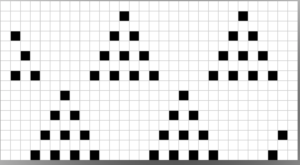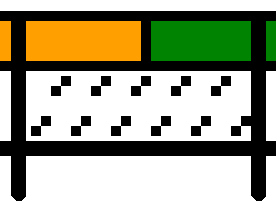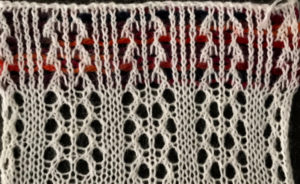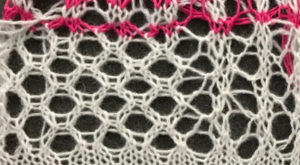1/8/18 It appears I now have acquired preselection from left to right on the first pass with my Ayab software, which I have been told is its “normal”. I am revising the information I have offered since I began working with Ayab if needed because of this, beginning with lace. This punchcard design is worked with each carriage operating for 2 rows, and all transfers in the same direction. The LC (lace carriage) on left, the KC (knit carriage) on right. An added note: sometimes punchcard designs may be used as provided, not altering the repeat in any way. Accidentally marking squares or pixels in the wrong spot, or deliberately starting with the LC on the wrong side, may still produce interesting fabrics. As always keeping good notes is more than well worth it. 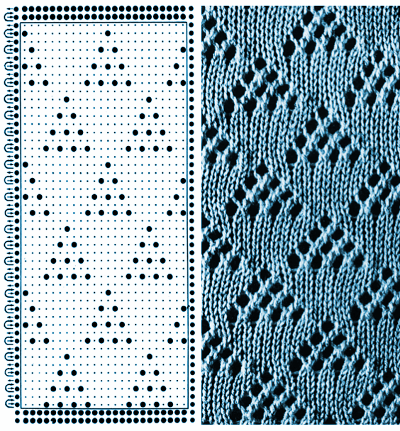 punchcard actions: transfers are all to the left (seen leaning to right on the knit side)
punchcard actions: transfers are all to the left (seen leaning to right on the knit side) With the first preselection row using Ayab beginning with the LC on the left, the same transfer sequences occur as in the punchcard machine or a single repeat on a mylar
With the first preselection row using Ayab beginning with the LC on the left, the same transfer sequences occur as in the punchcard machine or a single repeat on a mylar
swatch knit with the LC operating on the left, the KC on right throughout
For use with the color changer, the same repeat may be used. Transfers, however, now need to occur with the LC operating on the right giving the knit carriage the opportunity to travel to and from the color changer in 2 (or more, even #) row sequences. Using a punchcard, one would turn a punchcard over before inserting it into the card reader to work with the LC beginning on and continuing from the right. To achieve the same fabric using Ayab, shift the top row to the bottom of the repeat, and either mirror your image prior to importing it into Ayab, or use its mirror action in the pull-down menu. The chart shows the repeat prior to mirroring, with desired actions described to its right. It is not possible to read the first row from beyond the right set line using Ayab, so the LC begins on the left, travels to the right on the first blank row, selects on the second pass to the left, transfers stitches as it travels to the right again and stays there, operating from that side for the remainder of the knit. All transfers are now reversed and made to the right, and seen leaning to left on the knit side of the fabric. After the first 3 LC passes, each carriage operates for 2 rows at a time, all transfers are to the right, lean to the left on the knit side of the fabric.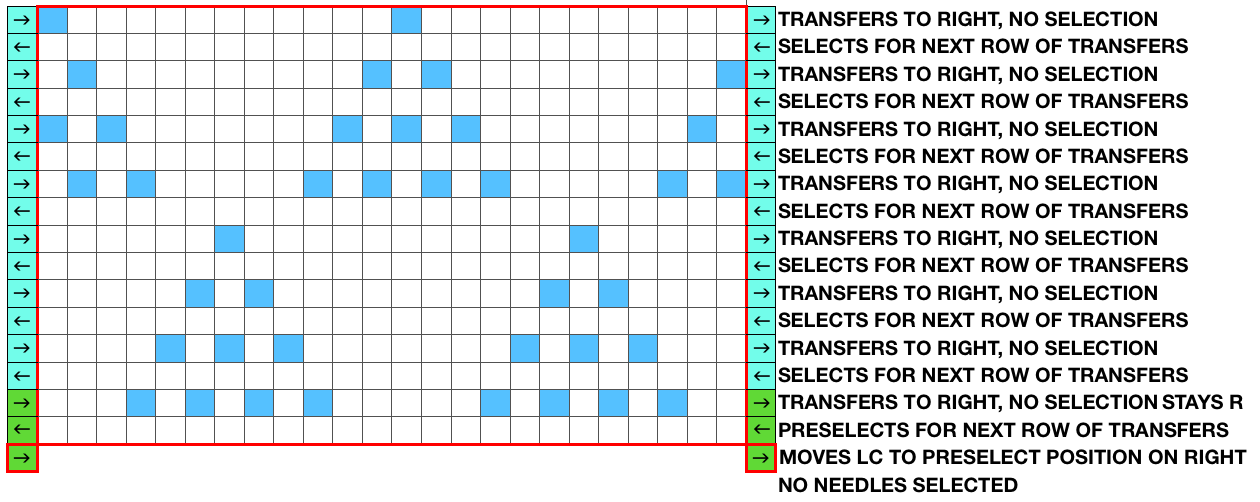

Possible striping choices: the differences between areas marked A or B is in the location of the color change. In A areas the color is changed immediately after the single transfer at the top of the “triangle”, in B areas the last eyelet is completed in the same color used up to that point, and the color change is made after the first row of 4 transfers at the base of the “triangle”. More complex lace repeats create much more interesting variations in the direction and movement of the stripes.
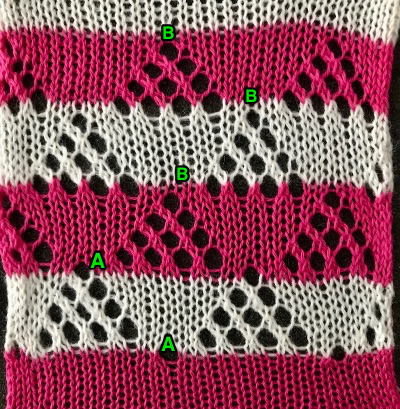 verification on a different day, LC on Left, repeat not mirrored
verification on a different day, LC on Left, repeat not mirrored
 The punchcard for fabric from 1/25/18 post. This fabric creates large eyelets, there will be 2 empty needles side by side for the duration. Some of the old pattern books referred to it as one of the “mock crochet” ones.
The punchcard for fabric from 1/25/18 post. This fabric creates large eyelets, there will be 2 empty needles side by side for the duration. Some of the old pattern books referred to it as one of the “mock crochet” ones.
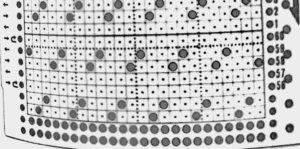
operating with LC on the left  operating with the LC on the right: the repeat is mirrored
operating with the LC on the right: the repeat is mirrored 
the original repeat (re-worked on 24 sts)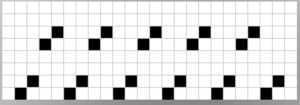 Ayab for operating with the LC on the left, repeat is mirrored
Ayab for operating with the LC on the left, repeat is mirrored  Ayab for knitting with LC on the right, original repeat, rows split
Ayab for knitting with LC on the right, original repeat, rows split
The bottom of the swatch was knit with the LC operating from Left, the top with the LC operating from right after its third pass illustrated in the “triangle” lace description above 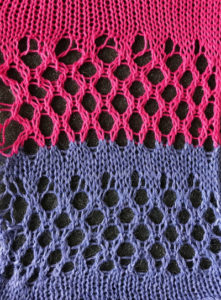 repeated testing, bottom LC operating from left, top LC operating from right
repeated testing, bottom LC operating from left, top LC operating from right 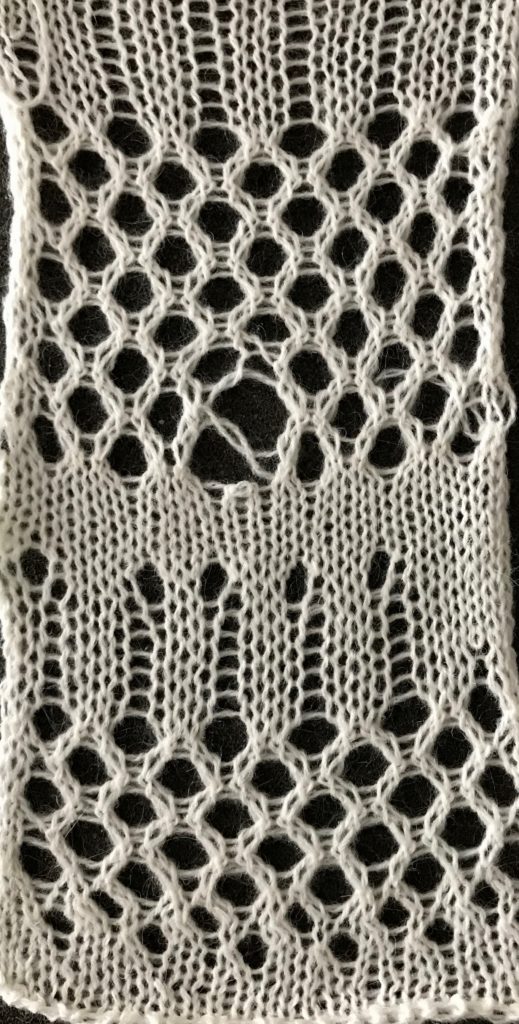 For a discussion of the same punchcard worked in a variety of ways see Lace meets weaving on Brother machines.
For a discussion of the same punchcard worked in a variety of ways see Lace meets weaving on Brother machines.
for full details. The punchcard was originally designed for operating both the knit and the LC carriages from the right. If KC I is used resulting in end needle selection on only the first and last needles in use, prior to passes of the LC push those needles back to B. If there are 3 empty needles on the edge on either side on rows preselected for weaving, bring the outside needle to work/ E prior to laying in the weaving yarn. 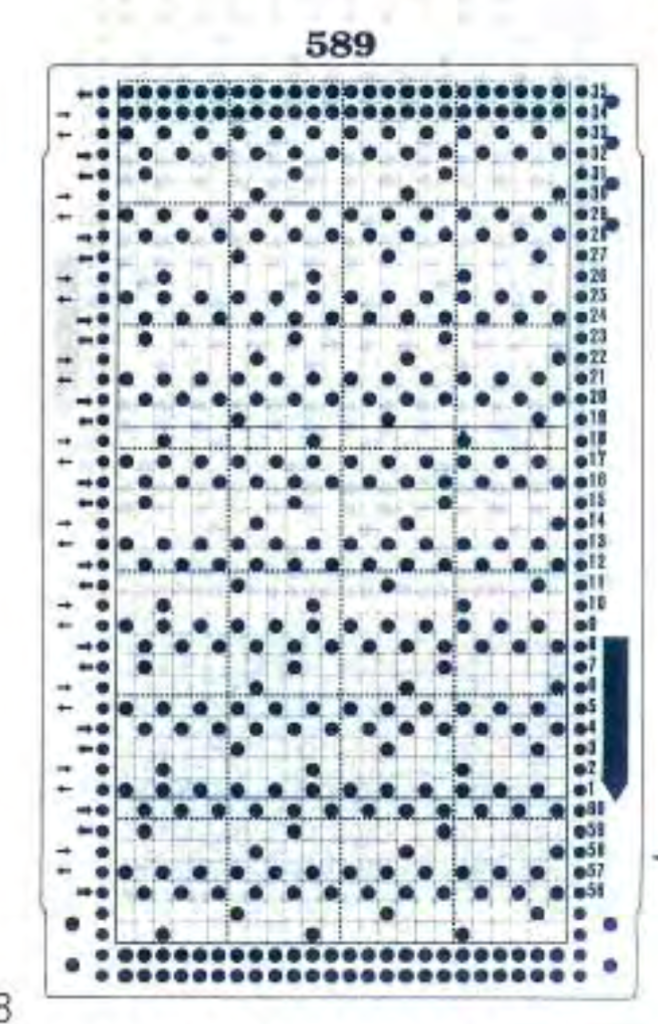 The image tiled for the width of my knit, in this case, 32 stitches, a multiple of 8
The image tiled for the width of my knit, in this case, 32 stitches, a multiple of 8 I actually cast on an extra stitch on each side at the beginning of the piece with the intent they not be in pattern and create a single knit stitch border in areas of transfers. Here are the results, barring a couple of spots the weaving yarn did not get caught properly. The pattern as drawn produces a fabric that is interesting, but different than the intended
I actually cast on an extra stitch on each side at the beginning of the piece with the intent they not be in pattern and create a single knit stitch border in areas of transfers. Here are the results, barring a couple of spots the weaving yarn did not get caught properly. The pattern as drawn produces a fabric that is interesting, but different than the intended 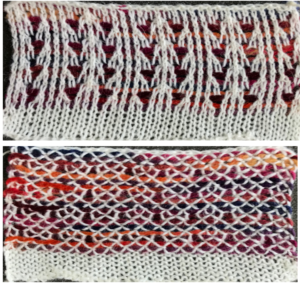 With the pattern flipped horizontally / mirrored, we now have the same results as in using the 589 punchcard
With the pattern flipped horizontally / mirrored, we now have the same results as in using the 589 punchcard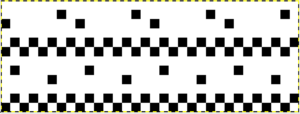
So to mirror or not to mirror? that is the question… I tested 643 and 650 from Pattern book #5, found mirroring was indeed required for transfer accuracy. I verified that the “triangles” do not need to be mirrored to match the punchcard swatch. The notable difference in the latter is that all transfers are in the same direction and that each carriage operates for only 2 rows.
Two more to try, directions are not ayab specific: a large diagonal eyelet lace combining lace and tuck
12/28/17: tuck lace meets hand technique 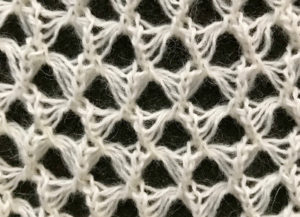
For more lace samples and symbols and suggestions from punchcard books on knitting the fabric, please see punch-card-book-symbols-and-samples
A Fair isle sample with deliberately mirrored lettering proved the program knits what it sees, so my letters were still reversed, as drawn.
On 12/25/17 I shared my first try at lace using Ayab and the workaround for the first pre-selection row occurring from left to right. The LC is the one to select for transfers, the KC knits to complete the formation of stitches. Brother punchcards for lace usually begin with selection rows, end with 2 blank rows at their top. Because Ayab requires a first pass from left to right for the next row to be selected, to get the pattern to work one needs to split the 2 rows at the top, bringing one of them down to the start of the repeat. If knitting continues with the LC pattern as originally drawn, the transfers will occur in the opposite direction of that intended. To work around that, the image may be mirrored in the paint program before download, or use action/mirror in the Ayab menu before knitting. One nice added feature is that blank rows may be left at both sides, creating a knit stitch border, and eliminating the problem of paying attention as to whether end needles are selected or not, and what measures to take. This fabric creates large eyelets, there will be 2 empty needles side by side for the duration. Some of the old pattern books referred to it as one of the “mock crochet” ones. These repeats do not hold with first-pass preselection from the left.
the original repeat  the repeat mirrored
the repeat mirrored  the resulting fabric, knit and purl sides
the resulting fabric, knit and purl sides

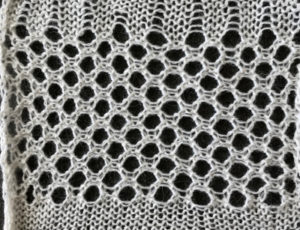 no mirroring, software patterning errors in one of the test swatches
no mirroring, software patterning errors in one of the test swatches
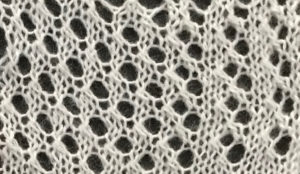 operating from the right, using the color changer
operating from the right, using the color changer
